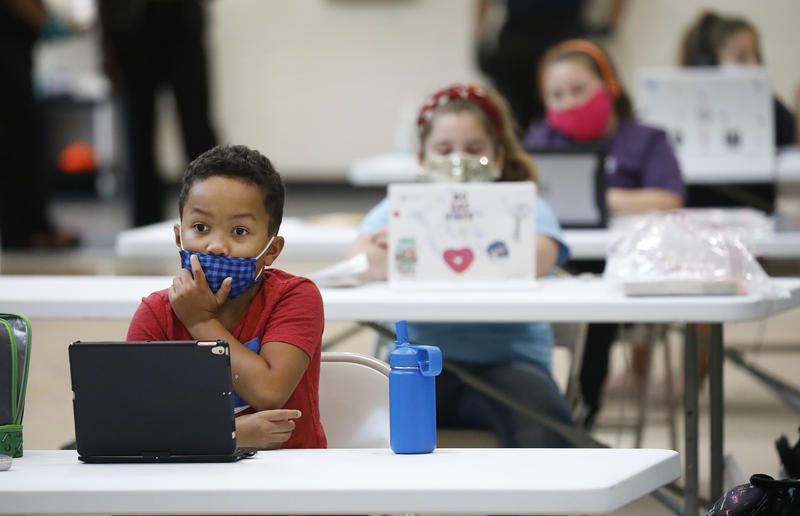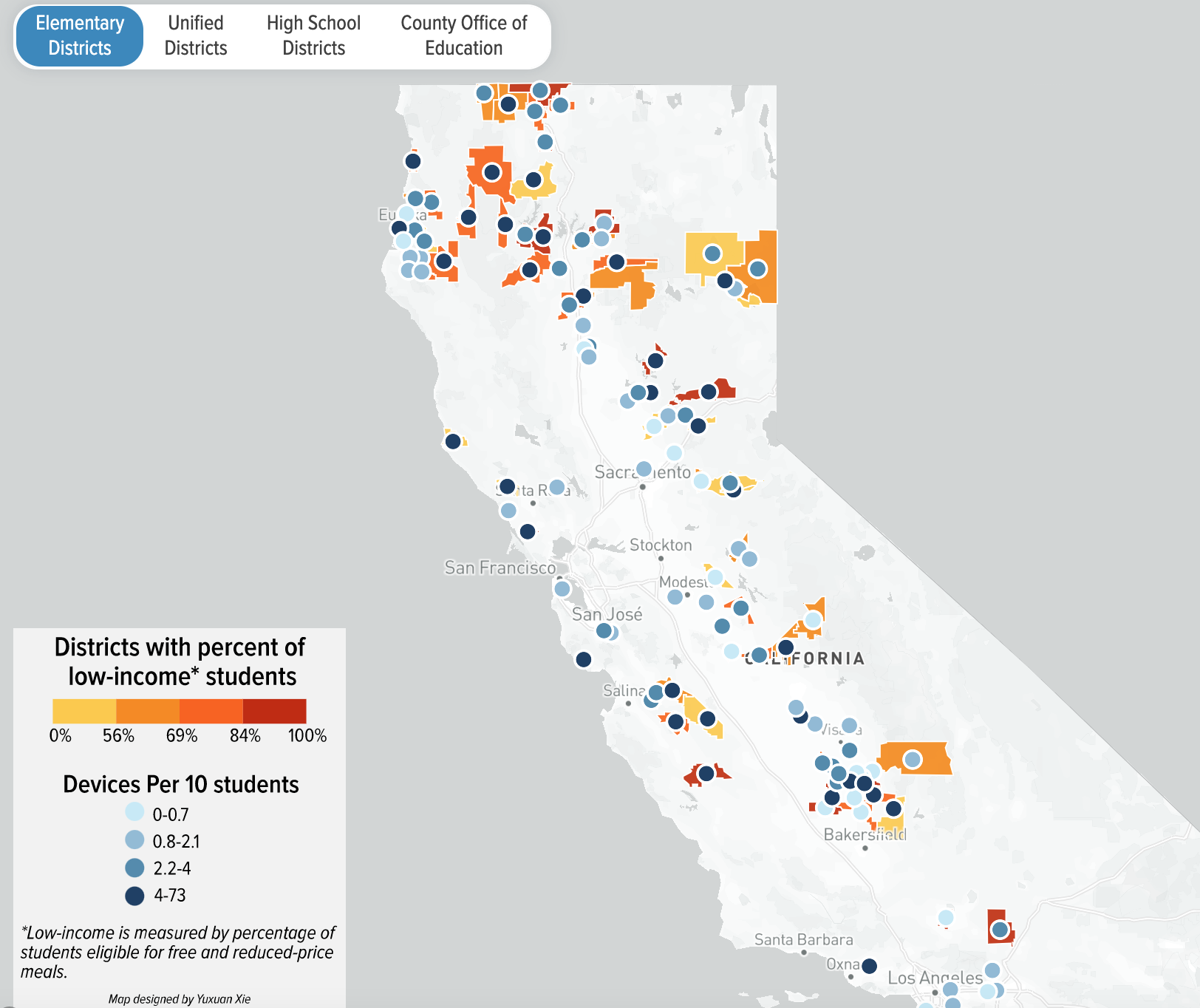A California program spent millions on devices for distance learning. Here’s where it went
Photo: Al Seib/Los Angeles Times/Polaris
Cameron Guidry, a quaternary grade pupil, is focused during his online class on Sept. 3 from his social distanced desk at the Delano Recreation Eye in Los Angeles.
 Photo: Al Seib/Los Angeles Times/Polaris
Photo: Al Seib/Los Angeles Times/Polaris
Cameron Guidry, a 4th grade student, is focused during his online form on Sept. 3 from his social distanced desk-bound at the Delano Recreation Eye in Los Angeles.
For the commencement time ever, the vast majority of California families say their kids take personal computing devices that they can use for school. But even afterward a year of distance learning, thousands of students still don't have a figurer or access to the internet at home.
After schools had to shut their buildings final leap due to Covid-19, most pivoted online, forcing districts and country officials to chop-chop shore up resources for extra computers and Wi-Fi hot spots for students who didn't have their ain devices or net admission at habitation.

Map: California Chromebook distribution during Covid-xix
View our interactive map displaying the concentration of Chromebook distribution at California schools, including data on how many low-income students attend.
Following an outcry from districts, the Californians Dedicated to Pedagogy Foundation, a private nonprofit fiscal manager for the California Department of Education, launched the Bridging the Digital Separate Fund to heighten money to buy technology. The fund prioritized small-scale, rural districts with high numbers of low-income students.
Overall, the devices went to rural districts, likewise equally some larger districts serving high numbers of low-income students, according to an EdSource analysis of data from the California Department of Educational activity. About 69% of the districts that received devices are in rural areas and predominantly serve depression-income families. Nearly half of all devices went to those districts, and the remaining went to larger suburban and urban districts with high portions of depression-income students. Many of the districts with high percentages of low-income students also have high percentages of English Learners, some other student group the program targeted.
The Bridging the Digital Dissever Fund was one of the few avenues through which the California Department of Education provided tangible devices to districts when schools closed, though several other simultaneous efforts took place to provide students with engineering science. In the midst of a global shortage of laptops, the program funded and distributed 45,884 Chromebooks, ane,103 Google management licenses, 70 wireless mice, 15 printers and four $500 drawing tablets, according to data provided to EdSource.
In improver, the California Department of Education received 100,725 donated hot spots from T-Mobile, with Google paying for service for three months, and other device donations direct to districts from engineering science companies including Lenovo, Hewlett Packard, Microsoft and Amazon. It also negotiated purchasing programs with distributors that districts could use, in addition to near $ii.one billion in federal CARES funding that California districts used to facilitate distance learning.
Despite efforts to appeal to Silicon Valley's large donors, however, hundreds of thousands of students are nevertheless estimated to exist without computers at home, according to recent information from the California Emerging Engineering Fund and the University of Southern California, which conducted a statewide survey of 575 California families in Feb and March.
As of March, 95% of California families with schoolhouse-age children said each of their kids had a device to utilise for remote classes, according to the USC and technology fund study. Almost three% said a computer was available but shared, and 2% said they didn't have a device. Most of those without a device are Spanish-speaking families, the study establish.
Other estimates, nonetheless, advise an even greater portion of students are still without devices after more than than a year of distance learning. Using data from the Demography Household Pulse Survey from April 2022 to March 2021, the Public Policy Institute of California establish that only about fourscore% of California students have access to computer devices in spring 2021, up from 67% when schools first closed in March 2020.
Since terminal summer, the Californians Defended to Education Foundation raised nearly $eighteen.4 meg for the Bridging the Digital Split Fund from philanthropists and tech companies including Google, Amazon, AT&T and VIPKid, a Chinese online tutoring company.
Several of the land's largest urban districts plant support from tech giants in their backyards, such as Twitter CEO Jack Dorsey's $10 million engineering science gift to Oakland Unified. Los Angeles Unified ready its own depression-price program with Verizon to provide internet service to students' homes and, more recently, the district passed a motion to continue to fund and monitor computer and internet access for students across the pandemic.
The amount and type of devices purchased through the digital divide fund ranged profoundly due to districts' reported needs. Santa Paula Unified, for example, serves about 5,000 generally low-income students living among Ventura County's orangish groves and received more than 1,000 Chromebooks last fall totaling $336,537. Others received much fewer, such as Female parent Lode Union Elementary in El Dorado County, where only nigh 1,000 students are enrolled. The district received about a dozen Chromebooks.
Today, virtually 85% of California residents use a reckoner, laptop or tablet to access the net from home, up from 78% in 2019, according to the USC survey. The share of residents who can just connect to the internet on a smartphone dropped from ten% in 2022 to 6% in 2021.
The authors of the report direct attribute that increased computer access to the role schools and programs such equally the digital divide fund played this past year in getting devices to the students who needed them most.
"We see a very significant affect of the provision of computers and tablets from school districts. Almost 75% of parents said their kid has a tablet or computer provided by the districts, most said after the pandemic started," said Hernan Galperin, principal researcher for the study.
Inequities in technology existed long before Covid-xix. Then when computers get the doors to the classroom during the pandemic, district and state officials had to act chop-chop to find solutions.
Using findings from a survey by the Pocket-sized Schoolhouse Districts Association concluding summer that gauged districts' device needs, the California Department of Didactics and its nonprofit partner worked with Office Depot to society and distribute the devices in bulk to 214 districts and 47 charter schools, about 1-fourth of all California school districts, co-ordinate to data provided to EdSource.
Districts that responded to the survey were then called to verify their needs, and small and rural schools were prioritized as devices became available. In one case those districts were contacted, land education officials reached out to midsize districts with loftier percentages of low-income students and English language learners to connect them with devices.
"These donations were the commencement pieces of the puzzle to getting our students connected and able to acquire from home," said Mary Nicely, senior policy adviser to State Superintendent of Public Instruction Tony Thurmond, who has been steering the department's efforts to shut the digital split this year.
"No ane is calling us saying they need devices. It's connectivity, that is the large event," Nicely said, referring to the even greater need for affordable high-speed internet service across California.
Acknowledging that many students still don't have devices or connectivity, she added, "Schools close down, so it was hard to effigy out how to get to students. I think we did the best we could with what nosotros had."
I reason why gaps in technology access are so catchy to identify in California is that districts are not required to collect or report data on student connectivity. Only that will shortly change: The California Department of Instruction recently hired a researcher to get together and map information from districts on student technology admission, Nicely said.
For districts like Santa Paula Unified, the donated devices were crucial during a crisis. Even though students are beginning to return to course, the donations sped up the district's pre-pandemic efforts to provide all students with computers and digital skills.
Most 90% of the district'due south 5,270 students come from low-income families, and 35% are English learners. Just earlier the pandemic, most students struggled to access the internet at habitation, said Michael Colmenares, the network technician for Santa Paula Unified. Some could just log on through a cellphone, which was difficult to practice any schoolwork on, and many didn't accept any blazon of device.
"It was a real moment of real desperation," Colmenares said. "At the time, we had no trouble in terms of affording devices, information technology was just finding availability. We were ownership any nosotros could go our hands on. And so those extra devices from CDE (California Department of Instruction) went to sites immediately, and it covered a huge portion of our students."
But more computers also led to more than issues. Many parts of California still lack broadband infrastructure and struggle to attract net service providers, which historically have avoided depression-population areas. And now, districts face new, ongoing costs for repairs and replacement devices, plus cyberspace service for students using district-managed hot spots.
"There were always places where service wasn't as potent or someone wasn't communicating what they need. Nosotros were constantly pounding the pavement putting out surveys and announcements," said Elizabeth Garcia, principal at Santa Paula High Schoolhouse. "We did a lot of home visits where nosotros replaced hot spots that weren't working. We always had staff on-site to address technology issues."
A handful of bills now making their way through the California Legislature aim to reform broadband funding in California and increase the coin available to address ongoing connectivity gaps. Thurmond is sponsoring two of those bills, SB 4 and AB 14.
Those efforts could also go a boost under President Joe Biden's $two trillion American Jobs Program infrastructure proposal, which would direct $100 billion to extend loftier-speed broadband infrastructure to reach 100% coverage nationwide and reduce the cost of broadband.
"All those kids who couldn't do homework from home or go along education at home aren't able to participate, and that's not right," Nicely said. "Fifty-fifty when the pandemic is over, this is not over."
To get more reports like this one, click here to sign up for EdSource's no-cost daily electronic mail on latest developments in didactics.
maccallumrionce40.blogspot.com
Source: https://edsource.org/2021/a-california-program-spent-millions-on-devices-for-distance-learning-heres-where-it-went/654590